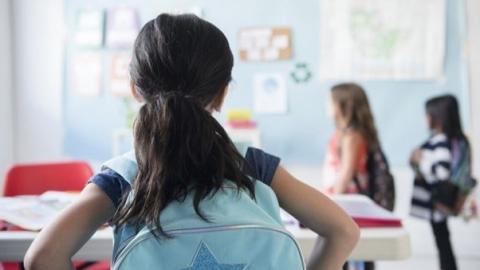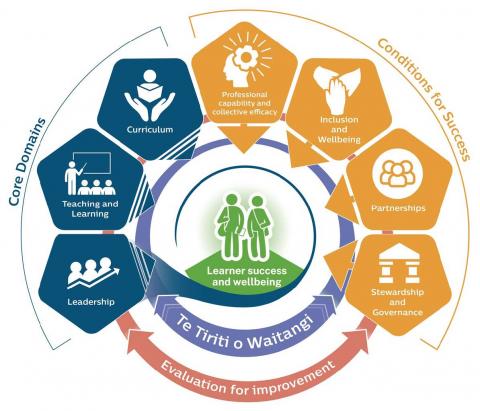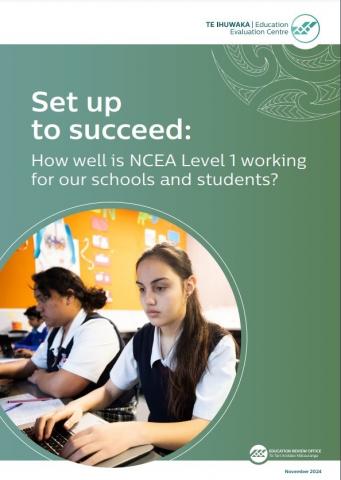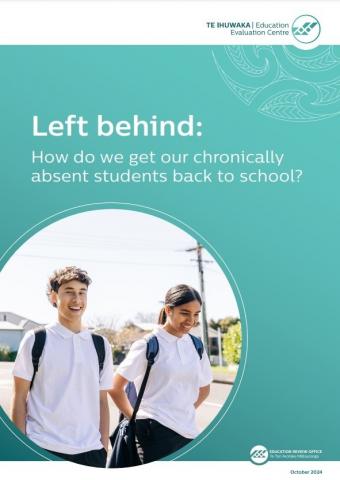
Tēnā Koutou Kātoa
Welcome to the first edition of Sharing the Mahi for 2025. I hope you and your team had a restful break over the summer and have had a successful start to the new school year.
Our 2025 evaluation programme is underway, with our team beginning to connect and engage with school leaders across the motu. I thank you for welcoming our evaluators into your schools and kura.
Our shared goal of improved learner outcomes depends greatly on learners attending school regularly and getting the most out of every lesson. To reflect this, our evaluations have a deeper focus on areas of learner success and wellbeing. This includes the four key areas of attendance, assessment, achievement, and progress. We are particularly interested in the quality of teaching practice and what you are doing to drive and maintain high attendance.
We want our published reports to be useful for parents, whānau and caregivers to understand what’s working well in schools and what needs improvement. Late last year, we refined our reports so that they’re clearer and easier to understand. The first of these new school reports are complete and due to be published on our website very soon.
We have made some changes to our review schedule for the first half of 2025. We will be in contact with those schools affected by the schedule change.
In today’s newsletter, you’ll find more information about the Teaching Observation Framework (TOF), the School Improvement Framework (SIF), the refreshed Board Assurance Statement (BAS) and find links to our latest research from our Evidence and Insights team.
We welcome your questions. Please get in touch with your Evaluation Partner if you have feedback for us.

In this newsletter:
• Shelley Booysen is our new Deputy Chief Executive for Review and Improvement Services
• The new school report
• Focusing on the quality of teaching and learning
• Have you explored the School Improvement Framework?
• What’s changed in the Board Assurance Statement?
• ERO's latest research
Shelley Booysen is our new Deputy Chief Executive for Review and Improvement Services
We are pleased to share that Shelley Booysen has been appointed Deputy Chief Executive of Review and Improvement Services, responsible for the programme of evaluation work in early childhood education services and schools across Aotearoa New Zealand.
Shelley’s name will be familiar to many, with more than 20 years as part of the ERO whānau. During that time, Shelley has evaluated early childhood education services, primary and secondary schools across the country, and was a pivotal part of our Pacific review programme team in Niue and Samoa.
Shelley has a wealth of experience, having held leadership roles in methodology development, internal evaluation of ERO programmes, professional development, and evaluation capability building with schools. Shelley also spent time in the Ministry of Education on secondment and worked as ERO’s portfolio/private secretary to the Minister of Education.
Most recently, Shelley was Director Schools.
Shelley has a deep understanding of our mahi across early childhood services, schools and kura, and has had an unwavering commitment to seeing improved outcomes for all learners and closing the equity gap.
Sharon Kelly will be acting Director Schools while we recruit for a permanent appointment in this role.
The new school report
We introduced our new school reports in Term 4 last year, and the first of these reports are now being confirmed.
The new school report is more parent-friendly, so parents, whānau and your community can more easily understand our evaluation findings.
The school report includes a parent summary, which details key information about learner success and wellbeing, attendance, assessment, achievement, and progress.
The next section of the report sets out our evaluation findings, key priorities and actions for you to use as part of your strategic and annual planning for ongoing improvement.
The last part of the report includes your school board’s attestation to meeting legislative and regulatory requirements, as well as provision for international and hostel students, if appropriate.
When your school report is published, we encourage you to share your report with your community, to ensure that parents and whānau can have the information they need to be active partners in their children’s learning.
We have developed a guide for parents and whānau to help them understand our school reports, you can find it here on our website. We encourage schools to share this link with your community when you share your confirmed report.
We want to hear from you and your community
When your confirmed report is sent to you, you will find a link to a brief survey seeking your views about the report's usefulness to you. Later in the term we will also reach out to groups of parents to gather their views on the new format. Your feedback will help us to continue strengthening the impact of our reporting.
Focusing on the quality of teaching and learning
Our Teaching Observation Framework (TOF) was trialed in schools and kura last year and is now ready to be used as part of the school evaluation process.
The TOF is a new tool we have developed for you to use alongside your Evaluation Partner to identify effective teaching practice in your school. The tool also helps you to see where shifts are needed to ensure all learners are engaged and getting the most from class time.
The TOF will support you and your Evaluation Partner to make judgements about where your school sits in the Teaching and Learning domain of the School Improvement Framework (SIF).
Your Evaluation Partner will work through the TOF with you during your next review.
Have you explored the School Improvement Framework?
Last year, we refined our School Improvement Framework (SIF), making it more deeply focused on what matters most for improved outcomes for learners. We are using the SIF as part of every school evaluation, and this year, some schools will be using this tool for the first time.
Like the Teaching Observation Framework, the SIF is a useful resource that you can use as a self-evaluation tool to understand more about your learners and identify what’s working well and what can be improved.
You’ll find the SIF and the accompanying resources here on our website. If you haven't used the SIF before, your Evaluation Partner will walk you through the tool as part of your school evaluation.
The image below shows the Theory of Improvement Diagram, identifying the focus of the SIF and how this supports improved learner outcomes.

What’s changed in the Board Assurance
Statement?
Boards around the motu will be pleased to know that our Board Assurance Statement (BAS) has been refined and shortened. It is more sharply focused on what matters most for learners, including health, safety and wellbeing, attendance, progress and achievement.
The content of the BAS is now more closely aligned to the information that our Evaluation Partners seek to verify as part of the evaluation process.
Boards will be pleased to note that there are fewer items on the Self-Audit Checklist, with Boards no longer needing to attest to finance or asset management items.
The process remains the same. Your Board completes the Self-Audit Checklist, and your Evaluation Partner will analyse and verify the information supplied.
The BAS and Self-Audit Checklists can be found here on our website along with a guidance document to support Boards as they work through the Checklists.
ERO'S LATEST RESEARCH
ERO is currently deep into our next round of research projects for 2025.
If you’d like to get involved, email teihuwaka@ero.govt.nz.
What drives success for school attendance?
Last year, we looked at chronic absence. This year, we will focus on identifying how changes to school practice can raise regular attendance, including: how school practice influences parents’ and students’ attitudes, how schools can motivate students to attend and overcome barriers to attendance, how we can support schools to raise attendance (including supporting schools to work together).
What does high-quality PLD look like?
ERO is exploring what the best evidence says about PLD for teachers, and what PLD currently looks like New Zealand. We aim to produce a framework and guidance to identify high quality PLD that develops teaching practice, including the design, selection and implementation of PLD. We’ll want to know what teachers and school leaders think about teacher PLD as it currently is.
Want to get involved?
We know that when schools participate in these evaluations it leads to compelling and convincing findings, and real shifts in the system. Principals across the country may start receiving emails to participate in our surveys and we thank you for your amazing help and contributions in completing these in the past!
If you want to get in touch with us directly, you can contact us at:
teihuwaka@ero.govt.nz
Keep up to date
All of our research and insights can be found on our dedicated evidence
website: https://evidence.ero.govt.nz/
We also regularly share news, links, and sneak peeks through our dedicated research social media accounts. Look for ‘Te Ihuwaka Education Evaluation Centre’ on Facebook, LinkedIn, and Instagram.
In case you missed reading these, here are some of our recent reports ...
Set up to succeed: How well is NCEA Level 1 working for our schools and students?

Leaving school with a qualification leads to better life outcomes, so ensuring Aotearoa New Zealand’s qualifications work well is essential for the success of our young people.
ERO reviewed NCEA Level 1 to find out how fair and reliable it is, if it is helping students make good choices, how motivating and manageable it is for students, and the impacts of recent changes. We also explored how valued it is and how implementation has gone so far.
Left behind: How do we get our chronically absent students back to school?

Chronic absence has doubled in the last decade. In Term 2 this year, over 80,000 students missed more than three weeks of school. These chronically absent students (at school 70 percent or less of the time) are often struggling and are at high risk of poor education and lifetime outcomes. ERO looked at how good the education system and supports are for chronic absence in Aotearoa New Zealand and found that we do not have a strong enough system or effective supports to address chronic absence.
For more information about ERO and our mahi please visit ero.govt.nz
To be added to our mailing list for Sharing the mahi, please email us at ricomms@ero.govt.nz